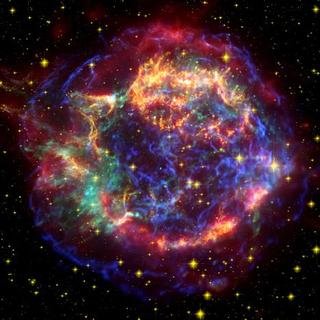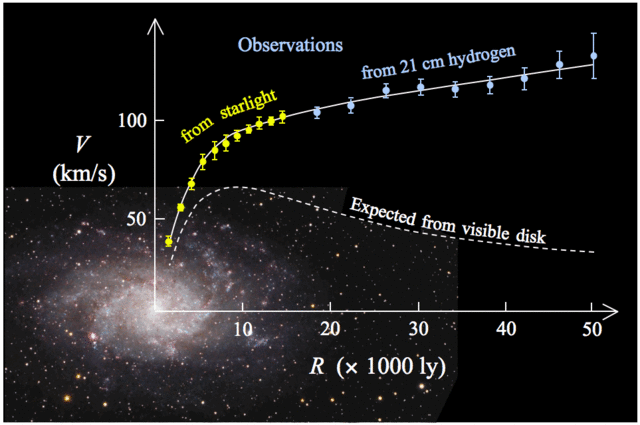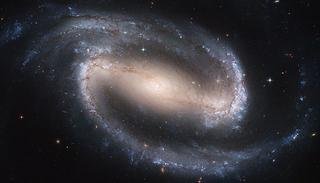Dark matter - from its origins to its freeze-out
Today, I will come back to the topic of astrophysics and cosmology. I will in particular discuss dark matter and one of the main mechanisms that explain how much dark matter there is in the universe today.
As we all know, we have plenty of indirect evidence that dark matter exists and pervades our universe (even if alternative theories are far from being dead too).

[image credits: NASA]
The amount of dark matter in the universe today is what is called the relic density of dark matter.
As it can be guess from the name, this relic consists in the dark matter quantity that is left over from the reactions that took place in the ancient times of the universe history.
Until recently, physicists were mostly considering a single mechanism relating the initial density of dark matter to its relic today, the so-called thermal freeze-out mechanism. This is the topic of this article.
Another mechanism explaining the amount of dark matter observed today has however been proposed and is now seriously considered by physicists, the so-called freeze-in mechanism. This will be the topic of a future article.
But before discussing all of this, it may be good to shortly rediscuss the dark matter hypothesis and how it was historically introduced.
DARK MATTER - THE ORIGINS
Even if one usually considers the origins of dark matter in the years 1930s, when Fritz Zwicky proposed it to explain the circular motion of the galaxies, the word itself is older.
It originates from the end of the 19th century, when physicists were trying to understand why stars were not evenly distributed in the universe. Lord Kelvin (the guy of the temperature units) found that there were some issues with the velocity dispersion of the stars: some mass was apparently missing (see here).
Another well known figure of that time, Henri Poincaré, (wrongly) disagreed with Kelvin's conclusions and was actually the one who introduced the concept of ‘dark matter’ for the first time (see here).
THE GALAXY ROTATION CURVES

[image credits: Wikipedia]
However, in the 1930, the first definition of the concept of dark matter as we know it today appeared with Zwicky, when he tried to explain the motion of stars observed in distant galaxies.
Using Newtonian mechanics and the amount of visible matter in these galaxies, Zwicky calculated the velocity which the stars should have. He reported it as a function of the distance from the galaxy center. This is the dashed curve that can be found on the figure on the right.
However, the measurements correspond to the yellow and blue points of the curve. As one can see, there is a mismatch. One way to restore agreement is to add, where needed, some invisible massive stuff. Using Newtonian mechanics again, one gets agreement between theory and data.
This may sound very ad hoc. Yes it is. However, many additional evidence for dark matter have been reported in the meantime, from the galaxy rotation curves to the cosmic microwave background data, the formation of the structures in the universe or the gravitational lensing, to quote a few of them.

[image credits: Wikipedia]
On a side note, one could equally have modified how gravity works at large distances to restore the agreement between theory and data. There is nothing wrong with that and it actually works.
However, it does not work as good as when we deal with the dark matter hypothesis, the corresponding significance being lower by a lot. This is why I personally prefer the dark matter hypothesis.
More information on modified gravity can be found in this older post of mine.
FREEZING-OUT DARK MATTER
In order to explain the amount of dark matter that is found today, there are several mechanisms on the market.
In the so-called freeze-out mechanism, the story starts in the very early universe and the density of dark matter evolves as in the curve shown below on the right. We are left today with a relic density of dark matter, and I will now explain where this comes from.

[image credits: Inspire]
We begin with assuming that in the early days of the universe, we have thermal equilibrium. In other words, the density of any single particle (including dark matter) equals the density of photons. This is where the curve starts on the left of the figure.
This means that two reactions occur. First, pairs of dark matter particles are created from the scattering of highly-energetic lighter particles. Second, pairs of dark matter particles annihilate into lighter particles.
As we have equilibrium, these two mechanisms compensate each other. This is the horizontal line on the left part of the figure. The density of dark matter does not change as we create a quantity of dark matter equal to the quantity of dark matter that is destroyed.
But with time passing by, the universe expands and cools down. Consequently, the lighter particles will at some point not have enough energy to create pairs of dark matter particles, and only the annihilation process survives.
As a result, the density of dark matter is reduced. This is the fast fall we can notice in the middle of the figure.
But the story does not end there. That would be too easy. The universe continues to expand and at some point, the dark matter particles will just be too fart from each other to meet and annihilate.
Consequently, dark matter cannot on the one hand be produced (as the universe is already too cold, as already said before), but it can additionally not annihilate anymore too. The density of dark matter becomes thus constant, as it is not affected by the interactions anymore.
This corresponds to the dashed lines on the rightmost part of the figure and is what is called the relic density of dark matter, as it is really a relic of ancient times where dark matter interactions mattered.
The vertical position of the correct dashed line is given by data, and I hope that the reason why one says that dark matter freezes-out is now clear.
TAKE HOME MESSAGE
In this article, I discussed one of the main paradigms that is capable to explain the amount of dark matter in the universe: the dark matter freeze-out scenario.
This of course assumes that one begins with accepting the dark matter hypothesis. It is good to recall that facts tend to point into that direction, but that alternative options have not been ruled out so far.
In a few words, our story starts right after the big bang, where dark matter is very abundant. Its density then evolves according to two reactions: dark matter production from lighter particles and annihilation into lighter particles.
The relative rates of these two reactions vary with time. They are equal and non-zero at the beginning, i.e. we have both dark matter production and annihilation. After some time, there is an epoch where only annihilation persists, so that the density of dark matter decreases. Finally, when the universe has sufficiently cooled down, both interactions stopped, and the density of dark matter is said to have frozen out.
Do not hesitate to ask questions, especially as it is winter time here and as everything freezes… ;)
For more discussion on this topic (or anything related to science), please join us on steemSTEM. SteemSTEM is a community driven project which seeks to promote well written/informative Science Technology Engineering and Mathematics postings on Steemit. More information can be found on the @steemstem blog.
We are currently consolidating the steemSTEM curation trail by different means. In the case where you would be interested, please contact us on the chat.
Thanks for such an informative post. I always loved astronomy and been fascinated by the Cosmos.
Thanks a lot for passing by, reading and commenting :)
It's a little weird, but in different versions of Wikipedia differs number of types of dark matter. In most cases mentioned only hot and cold dark matter. But sometimes there is information about warm matter. If I understand correctly, scientists have introduced an additional state of matter to explain the behavior of certain types of galaxy, because cold dark matter does not fit into their theories. What do you think about it? Do you agree that there is one more, intermediate state?
To say it roughly, this depends on the mass/velocity of the dark matter particle. In Standard Cosmology, we need cold dark matter, i.e. non relativistic dark matter, but this does not mean we 'only' need cold dark matter. We can have some admixture here.
At the origins, dark matter was introduced to explain the motion of the galaxies. But today, we have many more indirect evidence, as I said in the post. And dark matter needs to be cold, according to the evidence. As I said, non minimal cosmology is possible too, and in this case, you may have hot dark matter as well.
Warm dark matter is some form of dark matter whose speed is intermediate.
No. I neither agree nor disagree. You have models with a single dark matter species, and models with several of them. Both are allowed so far.
Wow! i have heard about dark matter only in science fiction movies and in comics, maybe because i am not an avid reader. This post actually makes me want to know about it in detail, anyway thanks for posting and spreading the info, looking forward to posts like these that, improves the intellect of people reading it :)
If you are interested, you can also look backwards as I have written a lot about dark matter :)
In any case, thanks for your comment. I hope you enjoyed the reading :)
Is there any such thing as "Anti dark matter"? Just like there's matter and anti matter
Or is the opposite of dark matter, "white matter"?
You have models where the dark matter particle is its own antiparticle, and models where these are different. They are in this case both dark matter (there is no reason to called it white or what so ever).
Thanks for the quick tutorial sir
This was indeed quick :)
Does the rate the sun move have any effect on dark matter detection? This subject is mostly enshrouded in darkness. A little light may help. Thanks for sharing this.
It does and can be used for detection. Please have a look on this post I wrote some time ago. Does it help?
It sure is 100% like an answer to this question. There's a professor I would have loved you to meet if ever you are in Africa. He'd love you for doing this. Thanks a lot.
I will come to Africa in 6 month: I will lecture at a school in Namibia. Still far from Nigeria ;)
Wow, Namibia is still far. The students of the school are real lucky. I hope you'd share your experiences here. That would be awesome to read.
Am not so sure there will be written lecture notes, but the lecture material (slides or pictures of the blackboard) should be public. I will give you the links in due time, if you send me a reminder (in due time :p)
Please which month exactly so I'd know when to remind you? Thank you very much.
July :)
Ok, inputted on my calendar. Thanks a lot.
Since you are saying with the dark matter freeze-out scenario, the amount of dark matter is now constant.
Is this the same G constant that Einstein used in his theory of a static universe?
Exactly. It is constant from the time dark matter freezed out.
The static universe theory has been ruled out for some time (by data). I am however not so sure to get the question. G is the gravitational constant, connected to the force of gravity. It is not a density ad is thus not connected to the density of dark matter today.
I made a mistake... I thought that the Gravitational constant Einstein used had the same value as the energy of dark matter in the universe
No problem. Humans are allowed to make mistakes :p
I suppose that what you mean by 'energy of dark matter' consists of its density :)
Very interesting post. Thanks for all the informations!
Thanks for your kind message :)